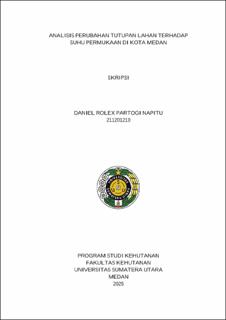| dc.description.abstract | Urbanization and population growth have led to increased human activities in urban areas, resulting in changes in land cover, such as the conversion of vegetated areas into non-vegetated or sparsely vegetated zones. This transformation has significant environmental impacts, particularly in the form of rising land surface temperatures. This study aims to analyze the distribution and changes in land cover, Normalized Difference Vegetation Index (NDVI), and Land Surface Temperature (LST) in 2014 and 2024, as well as to examine the relationship between land cover, NDVI, and LST. The findings reveal that the settlement area expanded by 1,392.50 hectares (4.86%), while the mangrove forest area decreased by 1,579.27 hectares (5.70 %). The most significant decline occurred in the very dense vegetation class, which reduced by 1,356.41 hectares (4.86 %). In contrast, the moderately dense vegetation class increased by 2,025.71 hectares (7.26 %). The reduction in vegetation coverage directly influenced land surface temperature, as evidenced by the largest decrease in the 26 – 29°C temperature class, covering an area of -4,805.21 hectares (17.23 %). Meanwhile, the highest increase in LST occurred in the 32 – 35°C range, which expanded by 6,126.03 hectares (21.96 %). Pearson Correlation analysis indicates a significant relationship between land cover, NDVI, and LST. Land cover with an LST value of -0.524 indicates a moderate correlation level with a negative relationship direction. The correlation value between land cover and NDVI is 0.519, which falls into the moderate correlation level. Meanwhile, NDVI and LST have a value of - 0.824, indicating a very strong negative correlation. | en_US |


